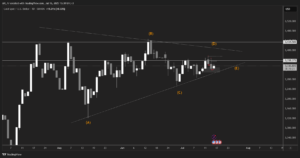Gold is heading for a weekly decline amid significant signals from the Federal Reserve.
Gold prices declined during trading today, Friday, heading towards a weekly loss as investors await further signals to gauge the potential extent of a U.S. interest rate cut in September. Bullion is on track for its biggest weekly drop since June 7, with prices falling by as much as 3% on Monday as investors liquidated positions amid broader stock sell-offs.
Federal Reserve policymakers believe that easing inflation will allow for interest rate cuts, guided by economic data rather than stock market turbulence. Fundamentally, gold is expected to benefit either from increased risk aversion or expectations of looser monetary conditions. Several scenarios could unfold in the coming months that may push gold prices to new record highs.
Meanwhile, data on Thursday showed that U.S. jobless claims fell more than expected last week, indicating that concerns about labor market disruption are overblown. Following last week’s U.S. monthly jobs report, banks like JPMorgan, Citigroup (NYSE), and Wells Fargo raised their expectations for a rate cut of 50 basis points during the Federal Reserve’s September meeting.
Investors’ focus now shifts to the U.S. Consumer Price Index (CPI) and Producer Price Index (PPI) due next week for further insights into the Federal Reserve’s policy path. On the other hand, physical gold demand in India increased slightly this week due to price corrections, although market volatility led some buyers to delay purchases, while premiums rose in China due to safe-haven buying.
Gold and the Dollar Now
Gold futures are stable at $2,463 per ounce, while spot gold is down about 0.1% at $2,424 per ounce. On the other hand, the dollar index is down 0.07% to 102.95 points.
Other Metals
Spot silver fell 0.1% to $27.54 per ounce, platinum rose 0.6% to $936.40, and both metals are heading for weekly losses. Meanwhile, palladium rose 0.8% to $929.75, with the metal registering an increase of more than 4% so far this week.
A Notable Bank Raises Recession Probability to a Dangerous Level
JPMorgan Chase (NYSE) has raised the probability of a U.S. recession this year to 35%, up from 25% in its mid-year forecast, according to a report released by the Wall Street giant on Wednesday.
In the memo, JPMorgan Chase economists discussed the weakening U.S. labor market, where recent data points to a slowdown in job gains and early signs of job losses. This decline in labor demand, coupled with slowing wage inflation, indicates a reduction in labor market pressures. Wage inflation in the U.S. is decelerating in a way not seen in other advanced markets, aligning with sustainable productivity gains to keep unit labor costs in line with the Federal Reserve’s inflation target.
Economists argue that easing labor market conditions and the resulting reduction in inflationary pressures bolster the case for a more significant policy adjustment by the Federal Reserve. They expect the Federal Reserve to cut interest rates by at least 100 basis points by the end of the year.
Economists also note that while global activity data remains strong, there are emerging signs of caution within the private sector. A recent business survey indicates a loss of momentum in global manufacturing and the Eurozone, weakening the connections that were expected to strengthen this year.
Despite these concerns, fundamental weaknesses typically associated with recessions, such as sustained margin pressure or credit market strains, are not currently present. JPMorgan’s revised recession probability is based on expectations that the Federal Reserve will respond to shifting growth and inflation risks with an early easing cycle. This early easing cycle is likely to improve growth prospects for next year.
JPMorgan also highlights that the easing of U.S. labor market conditions and wage inflation moderation is not evident elsewhere. The bank believes that the impact of Federal Reserve policy changes on other economies is limited without a concurrent shift in fundamentals. As such, economists stated, “There is a good chance that the shift away from the gradual approach we now expect from the Federal Reserve will not be broadly reflected.





